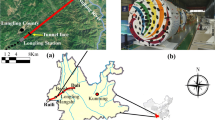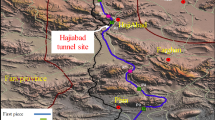Abstract
Although NATM is widely applied in modern tunnel design and construction, tunnel construction is still deemed highly risky due to the unknown ground condition ahead of the excavation face. Faults, massive groundwater, fracture zones, and other factors might easily cause great danger to the excavation work. To enhance the safety management of NATM, the tunnel seismic prediction (TSP) method is introduced to help detect unstable ground conditions to prevent the happening of collapses or disasters during tunnel excavation. With the reflected seismic waves collected from several explosions, TSP could produce high-resolution simulated images that, with careful interpretation, will reveal the ground conditions ahead. In this paper, how TSP is incorporated with NATM for better construction safety is presented.











Similar content being viewed by others
Data availability
All data, models, and code generated or used during the study appear in the submitted article.
References
Lüth S, Rechlin AJ, Giese R, Avaras JT, Gross K, Buske S, Jetschny S, Denil D, Bohlen T (2008) Seismic prediction ahead of a tunnel face: modeling, field surveys, geotechnical interpretation. Jpn Comm Rock Mech 4(2):47–51
Guo J, Luog C (2014) Application of tunnel seismic image approach to the advanced geological prediction for tunnel. J Multimed 9(7):879–885
Lu W, Wu J, Li S, Xu Z, Zhang LL, Zhou L (2015) Application study of the tunnel seismic prediction method in Qiyueshan tunnel. In: Proceedings of 3rd international conference on material, mechanical and manufacturing engineering, Shandong, China, pp 1725–1729
Dickmann T, Sander BK (1996) Drivage-concurrent tunnel seismic prediction (TSP). North tunnel mega-project, Verena, Switzerland, Felsbau vol 14, pp 406–411
New Asia Construction and Development Corp. (2015) TSP working plan for Chungren tunnel. New Asia working plan-28, pp 1–87, Taiwan, R.O.C.
New Asia Construction and Development Corp. (2016) The 6th TSP detecting report for Chungren tunnel. New Asia TSP detecting report-06, pp 1–136, Taiwan, R.O.C.
Gardner GHF, Gardner LW, Gregory AR (1974) Formation velocity and density—the diagnostic basics for stratigraphic traps. Geophysics 39:770–780
Christensen LR, Jorgenson DW, Lau LJ (1975) Transcendental logarithmic utility functions. Am Econ Rev 65:367–383
Lin F, Luan H, Zengc Y, Zhong Z (2017) Some new correlations of Q-value with rock mechanics parameters in underground oil storage caverns. Civ Eng J 3(8):537–546
Deere DU (1968) Geological consideration. In: Stagg KG, Zienkiewicz OC (eds) Rock mechanics in engineering practice. Wiley, New York, pp 1–20
Bieniawski ZT (1976) Rock mass classification in rock enginemen. In: Bieniawski ZT (ed) Symposium proceedings of exploration for rock engineering, vol 1. Balkema, Cape Town, pp 97–106
Barton NR, Lien R, Lunde J (1974) Engineering c1assication of rock masses for the design of tunnel support. Int J Rock Mech Min Sci 6(4):189–239
Barton N (2002) Some new Q-value correlations to assist in site characterization and tunnel design. Int J Rock Mech Min Sci 39(2):185–216
Hoek E, Kaiser PK, Bawden WF (1995) Support of underground excavations in hard rock. Taylor & Francis, New York, p 215
Palmstrøm A (1996) Characterizing rock masses by the RMi for use in practical rock engineering—part 1: the development of the rock mass index (RMi). Tunn Undergr Space Technol 11(2):175–188
Liu TY (2017) Use and discussion of pipe umbrella roofing and TSP in construction of NATM. Department of Civil Engineering, National Taipei University of Technology, Master thesis, Taipei
Acknowledgements
We want to express a special appreciation to New Asia Construction and Development Corporation, including the chairman, the president, the vice president, and the department managers, for their instruction and help on the study of this subject project. In addition, we would like to give a special thanks to Suhua Highway Improvement Office, including the director, the deputy directors, and engineers, for their instruction and supervision on contractors’ construction work of the Suhua Highway Improvement Project. Furthermore, their efforts on sustainability issues had reached outstanding achievements successfully during the past years. It is the most important help to complete this paper.
Author information
Authors and Affiliations
Corresponding author
Ethics declarations
Conflict of interest
On behalf of all authors, the corresponding author states that there is no conflict of interest.
Rights and permissions
About this article
Cite this article
Tzou, HK., Chu, TS. & Liu, TY. Enhancing the safety management of NATM using the tunnel seismic prediction method: a case study. Innov. Infrastruct. Solut. 5, 106 (2020). https://doi.org/10.1007/s41062-020-00357-0
Received:
Accepted:
Published:
DOI: https://doi.org/10.1007/s41062-020-00357-0




